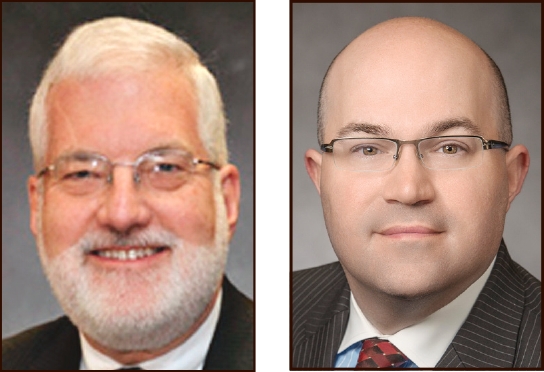Attorney's Column
Appellate Court Reminds Us That Not All Provisions Of Upstream Contract are Incorporated by Reference
By THOMAS H. WELBY, P.E., ESQ. and GREGORY J. SPAUN, ESQ.

As anyone in the construction industry knows, subcontracting is as widespread in the industry as hammers and nails. Given this state of affairs, it is important that contracts between an owner and general contractor, and the general contractor and subcontractor (and lower tier subcontractors) be harmonized to the greatest extent possible.
Nothing is more dangerous from a contractual standpoint than failing to properly flow all obligations and liabilities down, and flow all responsibilities up. A failure to do so can leave one of the intermediate contractors “holding the bag” as far as being liable for a downstream contractor’s failure, without any recourse against that contractor for such failure. A common way to address this issue is to incorporate the upstream contract by reference, often requiring that “subcontractors and suppliers of any tier will be subject to all terms and conditions of this Contract and the Prime Contract.”
However, as an appellate court recently reminded us in the case of Amerisure Insurance Company v Selective Insurance Group, even in the face of such language, not every provision will automatically flow down to a lower tier subcontractor.
Background
In August 2015, a group of three owners retained Eilerson Development Corp. to serve as the general contractor on a project to construct a movie theater in Buffalo, NY. One month later, Eilerson subcontracted its masonry scope of work to C&D Laface Construction. Both contracts required Eilerson and C&D to obtain insurance policies. Eilerson’s contract with the owners required Eilerson to include the owners as additional insureds on its insurance policy, insuring against claims caused by Eilerson’s negligent acts or omissions. C&D’s contract, on the other hand, only contained a provision requiring C&D to name Eilerson as an additional insured on its policy—not the owners. The C&D subcontract, however, contained a general incorporation by reference provision obligating C&D to the owners to the same extent as Eilerson was obligated to them under the prime contract. Both contractors procured the insurance policies required of them under their respective contracts; Eilerson procured its policy through Amerisure, and C&D through Selective.
Shortly after the project started, one of C&D’s employees was injured. This employee sued Eilerson and the owners, and ultimately Eilerson asserted third-party claims against C&D. Selective, C&D’s insurance carrier, assumed Eilerson’s defense under C&D’s policy, as an additional insured. Selective, however, refused to similarly assume the defense of the owners, arguing that it was not required to do so under the terms of its policy. In light of Selective’s failure to assume the owners’ defense, Amerisure did so under its own policy.
Eilerson and Amerisure sued Selective (and ultimately moved for summary judgment on that claim), arguing that Selective breached its policy by refusing to assume the defense of the owners, as required by the incorporated prime contract. In support, Eilerson and Amerisure noted that the Selective policy contained a provision “including as an additional insured under the Selective CGL policy ‘any person or organization whom [C&D] agreed in a written contract, written agreement or written permit that such person or organization be added as an additional insured on [the] policy,’” and argued that although the C&D subcontract itself did not require that the owners be named as additional insureds, the C&D subcontract incorporated all of Eilerson’s obligations to the owners, including the additional insured requirement. Selective also moved for summary judgment, arguing that the general incorporation by reference provision was insufficient to obligate C&D to anything that did not affect the scope, quality, character or manner of the work.
Decision
The motion court granted Selective’s motion and denied Eilerson’s/Amerisure’s motion. In doing so, the motion court held that the owners were not additional insureds under the Selective policy and, accordingly, Selective owed no duties to them under the C&D policy. Eilerson and Amerisure appealed, and the appellate court affirmed. Although the contract required the application of Virginia law (which the appellate court did), since there was a question of whether New York’s prohibition against foreign law applied, the Appellate Court also noted that the result would be the same under well settled New York law, which limits general incorporation by reference provisions to those terms which affect the scope, quality, character or manner of the work.
Comment
While the shorthand of general incorporation by reference provisions are seductive (they are short, easy to include, and purportedly all-encompassing), contractors must be warned that these provisions are ineffective to incorporate many of the provisions that are the most important to incorporate, such as: dispute resolution provisions; insurance provisions; specific record keeping requirements (such as certified payrolls); indemnification requirements; and termination provisions, amongst others. Rather, specific references must be made for these provisions in order for them to carry over. In that regard, contractors would be well advised to consult with experienced construction counsel when drafting or negotiating contracts so that they can be sure that the provisions that they wish to incorporate will actually make it over to the downstream contract. Otherwise, a contractor risks a gap in the obligations, which are flowed down, and may end up holding the proverbial bag.
About the author: Thomas H. Welby, an attorney and licensed professional engineer, is General Counsel to the Construction Industry Council of Westchester & Hudson Valley, Inc., and the Building Contractors Association, and is the Founder of and Senior Counsel to the law firm of Welby, Brady & Greenblatt, LLP. Gregory J. Spaun, General Counsel to the Queens and Bronx Building Association, and an attorney and a partner with the firm, co-authors this series with Mr. Welby.
